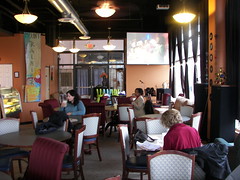Arts-based revitalization
Artist-based revitalization tends to be different than opening art galleries. It's something that happens when an area has a great amount of vacant property and needs a strategy to absorb it. Artists move in because the price is right. And provided there are a lot of other complementary positives, particularly location, historic building stock, and people with high household incomes willing to follow, neighborhood improvement occurs--often with displacement.
I think the issues in Anacostia are somewhat different. Crime and safety is an issue. There is underutilization of retail properties but not necessarily of residential properties. Furthermore, there aren't the kinds of large buildings that normally seed arts-based revitalization and the creation of formal or informal "arts districts."
My take anyway, in response to the Post article today, "Making a Place for Art in Anacostia," subtitled "A New Gallery Wants to Give SE a Boost, But Not Everyone Paints a Rosy Picture." From the article:
It's progress, a bright spot in the neighborhood. Or is it? Does Anacostia need to be saved by art? That depends on whom you're talking to.
Gallery organizers believe it can revitalize the neighborhood, as the Torpedo Factory Art Center did for Old Town Alexandria. Says Honfleur's Duane Gautier: "The big thing is, can we get a Starbucks or a Caribou. Then we'll know we've made it."

Artmosphere Cafe, Mt. Rainier
The Gateway Arts District in lower Prince George's County Maryland is probably a better example of how to go about doing this. They're seeding arts organizations that engage people, such as Joe's Movement Emporium. They built live-work housing for artists, offering relatively cheap rents to help build demand. On the ground floor is a kicking cafe, Artmosphere, not as big as Busboys and Poets on 14th Street NW, but with a great vibe. They sponsor artist studio tours and other events and resources, including a Glass Studio in Hyattsville. Although doing something like this costs more than the $50,000 to be spent on the Honfleur Gallery in Anacostia...
See for example:
-- Penn Avenue Arts Initiative in Pittsburgh, including this article from Pop City, "Recreating a Neighborhood through Art."
-- Social Impact of the Arts Project homepage at the University of Pennsylvania, and this related article "NYC INC: PERFORMING MIRACLES: Guess what has helped preserve Philadelphia's low-income neighborhoods? Small community arts groups."
Right now, I am reading The Creative Community Builder's Handbook. (I am trying to line up the author for a presentation in DC in late Spring.) This webpiece "Tools you can use: Tapping Local Arts and Culture to Revitalize Communities," summarizes the book's thesis:
Economic Development Strategies
1. Create Jobs: Nurture artists and small cultural organizations as businesses and microenterprises to increase employment
2. Stimulate Trade through Cultural Tourism: Create the right conditions for, and engage in, cultural tourism to bring new resources to the community
3. Attract Investment by Creating Live/Work Zones for Artists: Support artists and artist live/work spaces as anchors around which to build local economies
4. Diversify the Local Economy: Cluster arts organizations as retail anchors and activity generators to attract and support other enterprises
5. Improve Property and Enhance Value: Leverage the proximity of cultural amenities and the artists’ touch to improve property and increase its value
Social Development Strategies
6. Promote Interaction in Public Space: Engage people in public spaces through public art and collective cultural experience
7. Increase Civic Participation through Cultural Celebrations: Strengthen connections between neighbors through cultural celebrations and festivals
8. Engage Youth: Include young people in civic affairs and enterprises through meaningful work and activity
9. Promote Stewardship of Place: Develop civic pride and responsibility through good “place making” and design practices
10. Broaden Participation in the Civic Agenda: Expand involvement in civic issues and governance through community-centered arts and cultural practices
Index Keywords: arts-based-revitalization



0 Comments:
Post a Comment
<< Home